Roasted Garlic Sourdough Bread Recipe
This post may contain affiliate links.
If you've been wanting to try garlic sourdough bread, this rosemary garlic sourdough bread is exactly what you're looking for! The roasted garlic aroma that will fill your kitchen will soon become your favorite smell, I promise! It takes classic sourdough bread to the next level ... and beyond!
You'll need to have your own sourdough starter to make this sourdough loaf. And don't worry, if you've never roasted garlic before, I've included instructions for preparing the garlic cloves too!
And if you're looking for more sourdough bread recipes, why not try this parmesan cheese and rosemary sourdough bread, sourdough Pampushky, this sourdough rye bread, this Italian herb and cheese sourdough or if you are loving all things garlic, why not try these sourdough garlic bread bites (they're like garlic knots, only better) or this sourdough herb and garlic twist loaf.
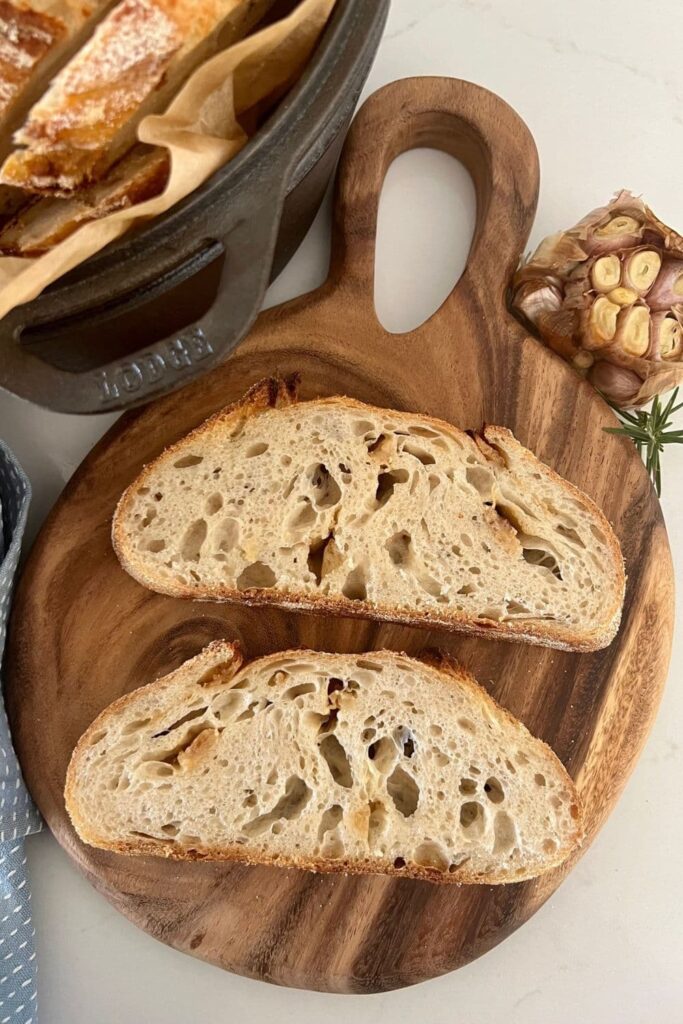
Why Use Roasted Garlic?
Garlic is such a wonderful ingredient. It has so many benefits and uses. The problem is, if you use raw or fresh garlic in your sourdough, it can have a negative effect on the magic that is fermentation. It will stop your sourdough from doubling during bulk fermentation.
For this reason, I recommend using roasted garlic. It's sweet, caramelised and creates the most wonderful flavor - especially when combined with fresh rosemary. And did I mention the sweet roasted garlic aroma? It's just incredible!
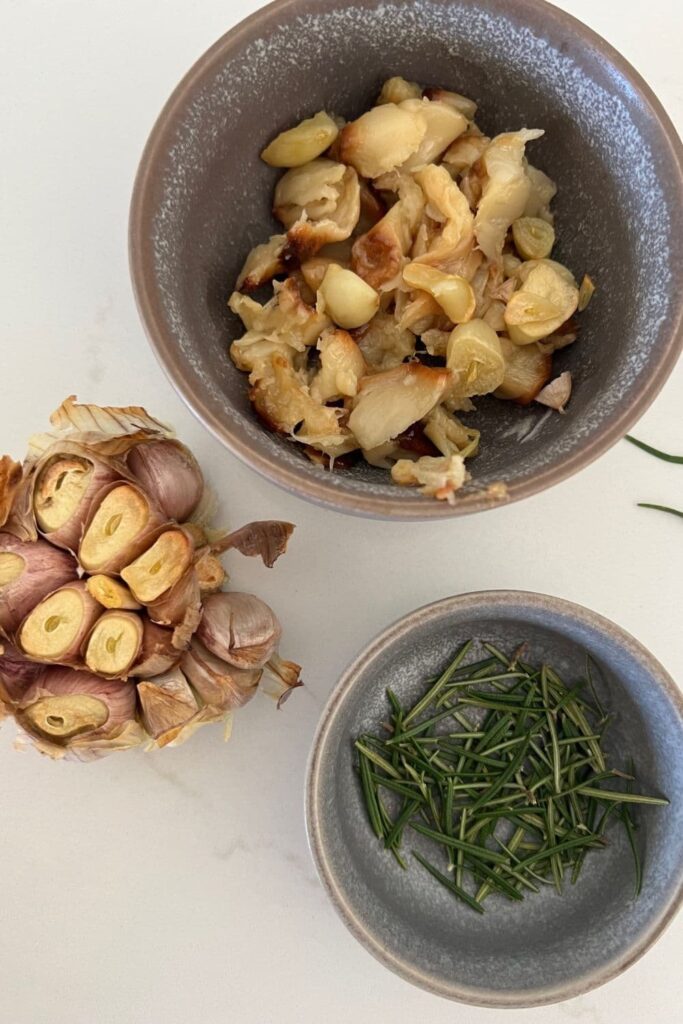
When To Add Garlic To Sourdough Bread?
In my experience, the best time to add roasted garlic to sourdough bread is at shaping. This ensures that dough is allowed to bulk ferment adequately before the garlic is added.
You can add the roasted garlic to the sourdough during the stretch and fold if you prefer, however after testing this loaf a number of times, I've had the best results from adding the garlic at shaping.
How To Make Roasted Garlic Sourdough Bread
I find it best to make the roasted garlic before starting the dough. I store the roasted garlic in the fridge and then just let it sit out for an hour before adding it to the dough during shaping.
The dough is very straight forward and follows the same process as my simple sourdough bread recipe.
First Let's Make The Roasted Garlic
Before you start making the dough, it's a good idea to prepare the roasted garlic cloves. Alternatively, you can roast the garlic while the sourdough is in the bulk fermentation stage.
Slice the heads of garlic across the top so that the cloves are exposed. Place the heads of garlic onto a baking tray lined with parchment paper. Drizzle the heads of garlic generously with olive oil and place into the oven at 356F/180C for around an hour, or until they are soft and golden brown.
Remove roasted heads of garlic from the oven and allow them to cool. Once cool, gently squeeze out the cloves of garlic. Set aside until you are shaping your sourdough (they keep in the fridge for a few days).
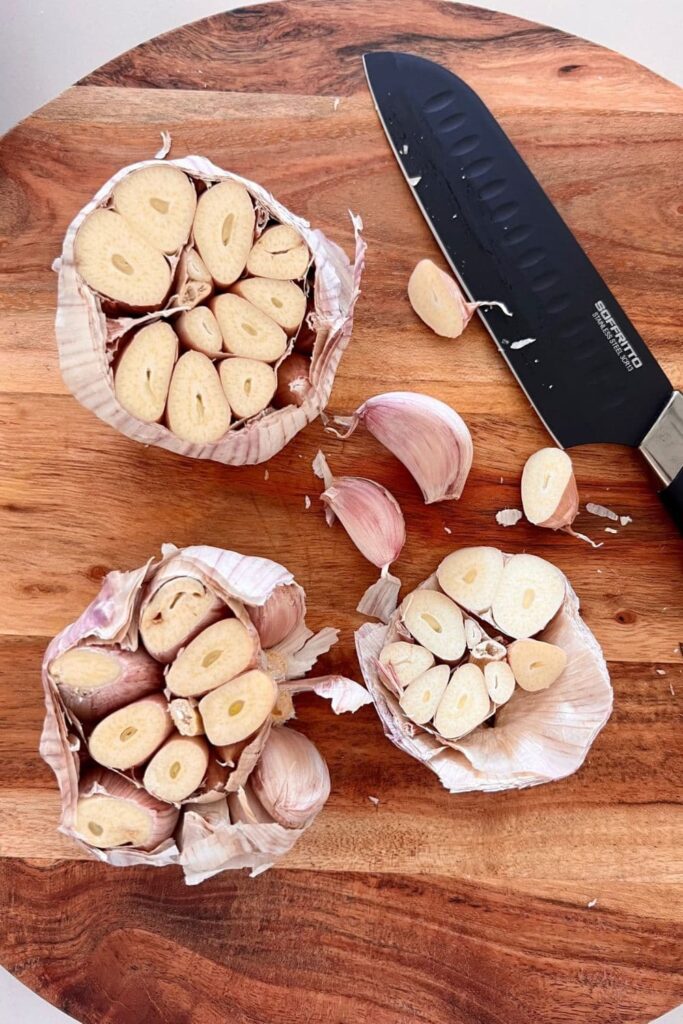
Now Let's Make the Sourdough!
Autolyse - Premixing The Dough
Weigh out your sourdough starter and water into a large bowl - whatever you have in the cupboard is fine!
Mix the water and starter together briefly. Then add your flour and salt and mix whole lot together to form a shaggy dough.
The dough will be fairly shaggy and only just brought together. You might wonder how this will turn into bread, but just wait, time is your friend and the dough will change in around an hour.
Cover your bowl with an elastic food cover or plastic wrap and let it sit for around 1 hour.
This process is called the "autolyse" and allows your flour to soak in all the water and become hydrated. You can read all about autolyse vs fermentolyse here.
Forming Up The Dough
After the dough has been through autolyse you need to bring it together into a ball. Work your way around the bowl, grabbing the dough from the outside, stretching it up and over itself, into the centre, until a ball is formed. You shouldn't need more than about 20-25 stretches to form the ball.
You'll notice that the dough is fully hydrated after soaking all the water up. It will be fairly sticky but as you bring it into a ball, it will become smoother and shinier.
Once the dough has formed into a smooth ball, pop the cover back on and let it rest for 30 minutes.
Stretch & Fold - Creating Structure
Over the next few hours you need to create some structure for your dough by "stretching and folding".
Aim to do around 4-6 sets of stretches and folds.
For each set, stretch the dough up and over itself 4 times. Leave around 15 minutes in between each set. Again you do not have to be exact with time, but you need to do at least 4 sets over 2 hours.
You can see how stretches and folds look here.
Bulk Ferment
Once you've finished your stretch and folds, cover the dough with a plastic cover (a recycled plastic bag is perfect) and allow the dough to bulk ferment at room temperature. If you're not sure when bulk fermentation is over, you can check out this guide to bulk fermentation.
Shaping The Dough
Once your dough has finished its first ferment, it's time to shape it and add the garlic (and rosemary if you are using it).
You'll need to flour your counter top with rice flour for this (we use rice flour because it has no gluten). Try to be quite sparing with the rice flour, you only need a very light dusting.
Use a dough scraper to gently ease the dough out of the bowl (your hands work just fine if you don't have one). You want it to land upside down on your counter so that the smooth top of the dough is on the countertop and the sticky underside is facing up. This will make it easier to shape.
Before you shape the dough, pull it out into a rough rectangle. Place pieces of the roasted garlic and rosemary all over the dough. As you shape it into a batard, place pieces of garlic and rosemary on every fold (you can see photos of me doing this above. You can also see a video of me shaping a batard here.
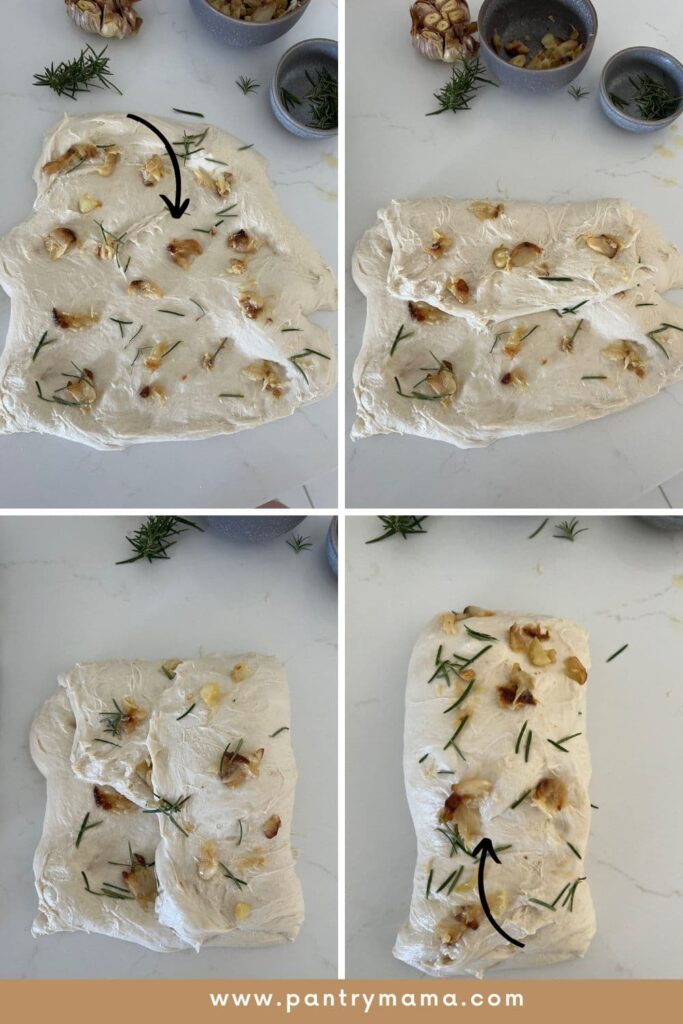
When you have finished shaping, the garlic should be neatly tucked inside the dough.
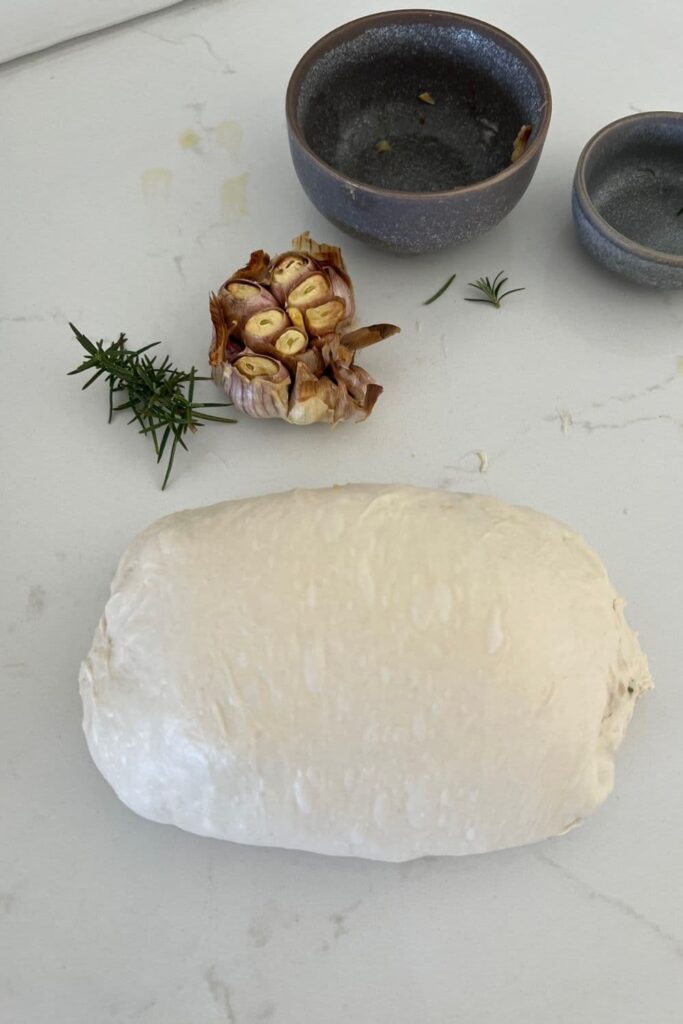
You will need a proofing basket or container to put your dough into. You can find more notes on what to use as a banneton here.
Whatever you're using needs to be liberally floured with your rice flour.
Placing Into A Proofing Container
Once the dough is shaped into a tight ball, place it into your proofing basket or container smooth side down, so your seam is on the top.
If you're using a cloth or tea towel in a bowl it's ok to put your dough with the smooth side up. Just make sure the dough is tight.
Lift your dough around the edges to pop a little more rice flour if you feel it needs it. Just try to handle the dough as little as possible and be really gentle as you really want to preserve all the gases and air bubbles that have formed during your bulk ferment.
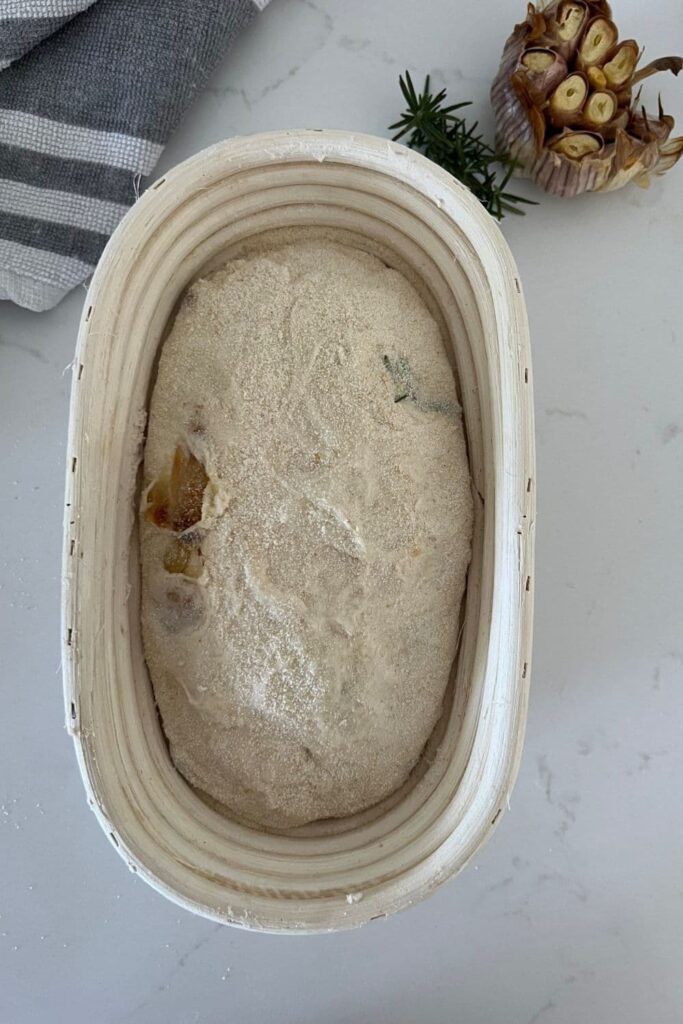
Cold Ferment (optional)
Now the dough is in its "shaping container" cover it loosely with a plastic bag and place into the fridge.
I use a large plastic bag to cover it - I just reuse it each time.
Try to leave it in the fridge for a minimum 5 hours. Cold fermentation adds extra flavor to this sourdough bread dough.
Preparing to Bake Roasted Garlic Sourdough Bread
Once you're ready to bake your sourdough, you'll need to preheat your oven to 230C/450F.
Place your Dutch Oven into the oven when you turn it on so it gets hot. Try to preheat for around 1 hour to ensure your oven is super hot - but you know your oven so just adjust this time if you need to.
Leave your dough in the fridge (or counter) until the very last minute - placing a cold dough into a hot oven will give you a great "spring".
When your oven is at temperature, take your sourdough out of the fridge. Gently place it onto a piece of parchment paper or silicone sling if using.
Gently score your bread with a clean razor blade or knife. At minimum a large cross is sufficient, but you can get as artistic as you like. You can find my full guide on how to score sourdough bread here.
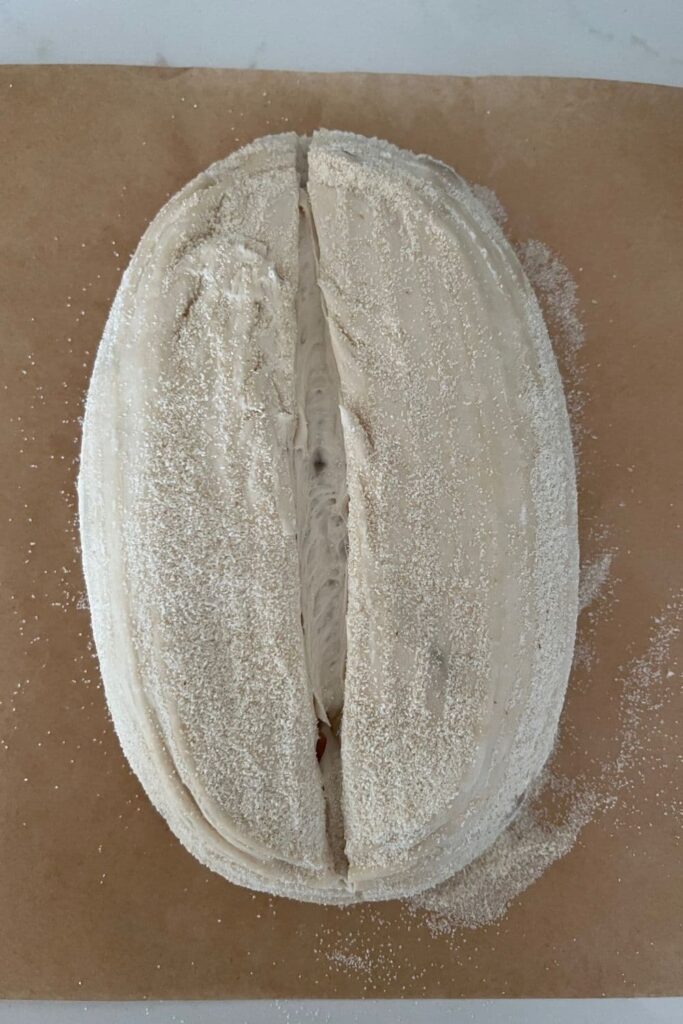
Carefully take your dutch oven out of the oven. Place the sourdough into the pot using the silicone sling or parchment paper as a handle. Put the lid on and place into the hot oven.
If you want to you can spritz your dough with extra water before you put the lid on.
BAKE TIME:
- 30 Minutes with the lid on at 230C/450F plus
- 10-15 Minutes with the lid off at 210C/410F
Finishing The Bake
When you remove your dough from the oven, carefully remove it from the oven as soon as possible and place on a wire rack to cool.
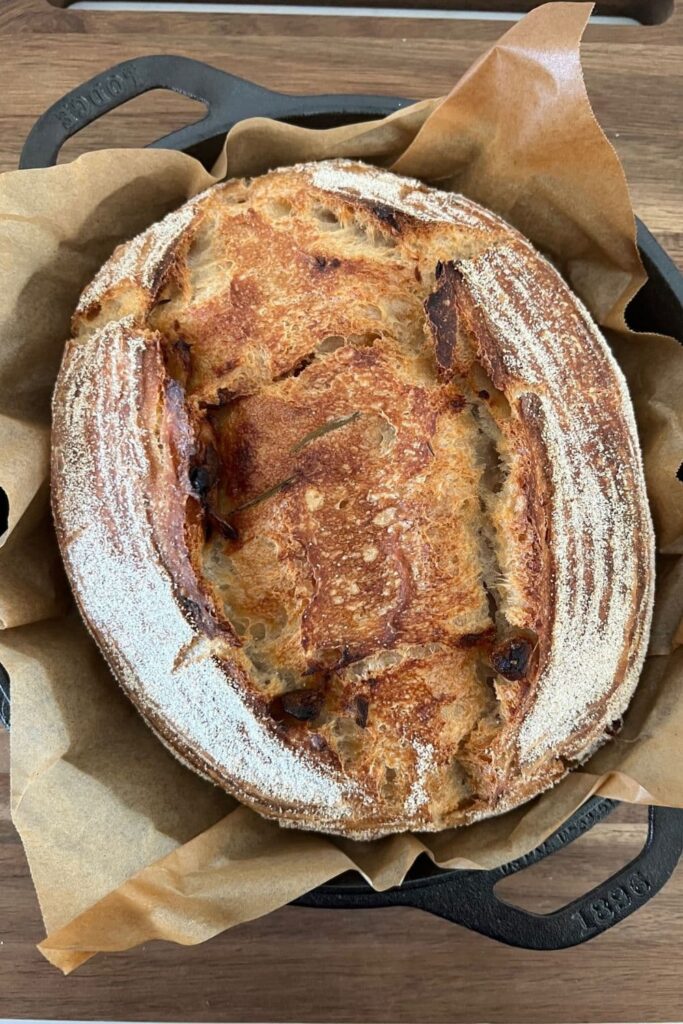
What Else Can You Add To Roasted Garlic Sourdough Bread?
I have added fresh rosemary to this loaf of roasted garlic sourdough bread, but there are a few other ingredients you might like to add to your loaf, such as:
- Shredded Parmesan Cheese
- Asiago Cheese
- Ground Black Pepper
- Roasted Onions
Frequently Asked Questions
You can either leave the rosemary out if you want to, or you can replace it with other fresh herbs. Fresh thyme, finely chopped chives or sage work really well in place of rosemary.
It's much better to use high protein bread flour for this sourdough bread recipe. If you use all purpose flour, you will need to make the adjustments as mentioned here.
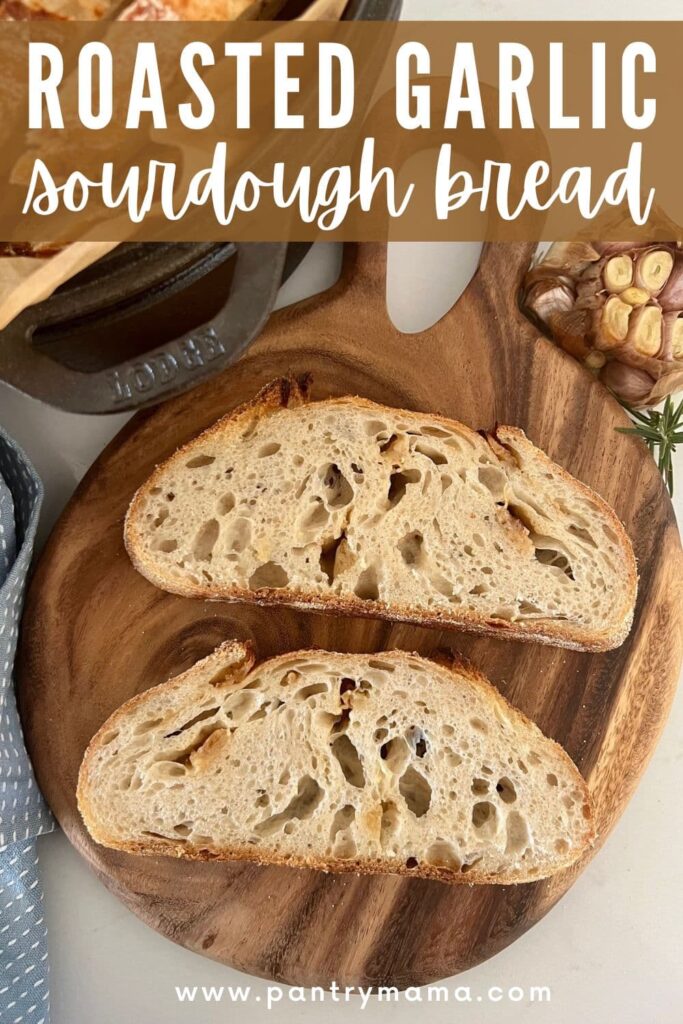
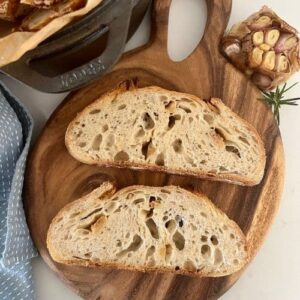
Roasted Garlic Sourdough Bread Recipe
Equipment
- Basic Kitchen Scale (grab them for as little as $10 here)
- Mixing Bowl
- Dutch Oven
Ingredients
- 500 g Bread Flour
- 350 g Water
- 100 g Sourdough Starter (Fed and Bubbly)
- 10 g Salt (increase or decrease according to your taste)
- 2-3 Heads of Garlic
- 20 g Olive Oil
- Fresh Rosemary Optional
Instructions
Roasted Garlic
- Before you start making the dough, it's a good idea to roast the garlic. Alternatively, you can roast the garlic while the sourdough is in the bulk fermentation stage.Slice the heads of garlic across the top so that the cloves are exposed. Place the heads of garlic onto a baking tray lined with parchment paper. Drizzle the heads of garlic generously with olive oil and place into the oven at 356F/180C for around an hour, or until they are soft and golden brown.Remove roasted heads of garlic from the oven and allow them to cool. Once cool, gently squeeze out the cloves of garlic. Set aside until you are shaping your sourdough (they keep in the fridge for a few days).
Making the Sourdough
- Autolyse - Premixing The DoughWeigh out your sourdough starter and water into a large mixing bowl - whatever you have in the cupboard is fine!Glass is always good as you can see what's happening underneath your dough. But any plastic, ceramic, stainless steel or glass bowl is fine! Mix the water and starter together briefly. Then add your flour and salt and mix whole lot together to form a shaggy dough. The dough will be fairly shaggy and only just brought together. You might wonder how this will turn into bread, but just wait, time is your friend and the dough will change in around an hour.
- Cover your bowl with an elastic food cover or plastic wrap and let it sit for around 1 hour. This process is called the "autolyse" and allows your flour to soak in all the water and become hydrated.
- Forming Up The DoughAfter the dough has been through autolyse you need to bring it together into a ball. Work your way around the bowl, grabbing the dough from the outside, stretching it up and over itself, into the centre, until a smooth ball is formed. You shouldn't need more than about 20-25 stretches to form the ball.You'll notice that the dough is fully hydrated after soaking all the water up. It will be fairly sticky but as you bring it into a ball, it will become smoother and shinier.
- Once the dough has formed into a smooth ball, pop the cover back on and let it rest for 30 minutes.
- Stretch & Fold - Creating StructureOver the next few hours you need to create some structure for your dough by "stretching and folding". Aim to do around 4-6 sets of stretches and folds. For each set, stretch the dough up and over itself 4 times. Leave around 15 minutes in between each set. Again you do not have to be exact with time, but you need to do at least 4 sets over 2 hours.
- Bulk FermentOnce you've finished your stretch and folds, cover the dough with a plastic cover (a recycled plastic bag is perfect) and allow the dough to bulk ferment at room temperature.
- Shaping The DoughOnce your dough has finished its first ferment, it's time to shape it and add the garlic (and rosemary if you are using it).You'll need to flour your counter top with rice flour for this (we use rice flour because it has no gluten). Try to be quite sparing with the rice flour, you only need a very light dusting.Use a dough scraper to gently ease the dough out of the bowl (your hands work just fine if you don't have one). You want it to land upside down on your counter so that the smooth top of the dough is on the countertop and the sticky underside is facing up. This will make it easier to shape.Before you shape the dough, pull it out into a rough rectangle. Place pieces of the roasted garlic and rosemary all over the dough. As you shape it into a batard, place pieces of garlic and rosemary on every fold (you can see photos of me doing this above. You can also see a video of me shaping a batard here.When you have finished shaping, the garlic should be neatly tucked inside the dough.You will need a proofing basket or container to put your dough into. You can find more notes on what to use as a banneton here.Whatever you're using needs to be liberally floured with your rice flour.
- Placing Into A Proofing ContainerOnce the dough is shaped into a tight ball, place it into your proofing basket or container smooth side down, so your seam is on the top.If you're using a cloth or tea towel in a bowl it's ok to put your dough with the smooth side up. Just make sure the dough is tight.Lift your dough around the edges to pop a little more rice flour if you feel it needs it. Just try to handle the dough as little as possible and be really gentle as you really want to preserve all the gases and air bubbles that have formed during your bulk ferment.
- Cold FermentNow the dough is in its "shaping container" cover it loosely with a plastic bag and place into the fridge. I use a large plastic bag to cover it - I just reuse it each time. Try to leave it in the fridge for a minimum 5 hours.
- Preparing to BakeOnce you're ready to bake your sourdough, you'll need to preheat your oven to 230C/450F. Place your Dutch Oven into the oven when you turn it on so it gets hot. Try to preheat for around 1 hour to ensure your oven is super hot - but you know your oven so just adjust this time if you need to.Leave your dough in the fridge (or counter) until the very last minute - placing a cold dough into a hot oven will give you a great "spring".When your oven is at temperature, take your sourdough out of the fridge. Gently place it onto a piece of parchment paper or silicone sling if using. Gently score your bread with a clean razor blade or knife. At minimum a large cross is sufficient, but you can get as artistic as you like. You can find my full guide on how to score sourdough bread here.Carefully take your dutch oven out of the oven. Place the sourdough into the pot using the silicone sling or parchment paper as a handle. Put the lid on and place into the hot oven. If you want to you can spritz your dough with extra water before you put the lid on.BAKE TIME:30 Minutes with the lid on at 230C/450F plus10-15 Minutes with the lid off at 210C/410F
- Finishing The BakeWhen you remove your dough from the oven, carefully remove it from the oven as soon as possible and place on a wire rack to cool.
Notes
- Notes on Flour: This recipe is written using strong Bread Flour. Bread flour has a higher protein content than All Purpose flour. If you choose to use All Purpose flour you may have a different result because of this. You can read more about the differences between All Purpose Flour and Bread Flour here.
- Notes on Sourdough Starter: This recipe is based on you having an active starter that you have fed a few hours before starting your bake. For info on how to make a sourdough starter, go here.
- Notes on Stretch & Folds: If you are going to do the stretch & folds on your bench top, spray your surface with water mist rather than using flour. You can leave the dough in the bowl if you want to. Wet your hands to stop the dough sticking - although it shouldn't be too sticky. It will get less sticky as you do your stretches and folds. For more information on how to do stretch and folds, go here.
- Notes on Bulk Fermentation: If your home is warm then your dough will ferment a lot faster and could be done in as little as a few hours. If it's colder, it will take longer. I recommend using this overnight sourdough bread recipe in cooler temperatures, as if it's too warm the dough will over ferment while you're sleeping and you'll wake up to a bowl of soupy dough!
You will know your dough is ready to move to the next stage when it has *just* doubled in size. It will be fairly wobbly and full of bubbles. You should be able to see large air bubbles under the surface of the dough.
You don't want to let it go any further than doubled as it will be over fermented.
If you want to do an overnight ferment, but your home is warm, consider using a little less starter (ie 25g).
Less starter means your dough will take longer to ferment and you will reduce the risk of over fermenting your dough. You'll find more information on these topics here:
When is my bulk ferment finished? What is the difference between cold ferment and bulk ferment? Why does the amount of starter matter?
- Notes on Baking: If you're worried about the base of your bread burning, place a baking sheet on shelf underneath your Dutch Oven - it works! If you're worried about your bread not being cooked all the way through, turn the oven off and place your dough straight onto the oven rack. Leave the door ajar and let your bread rest there for a few hours. Make sure you don't close the door or your sourdough will sweat and you'll get a wrinkly, soggy crust. Remember not to cut into your loaf too soon - you'll need to let it cool for at least a few hours (4-6 is best).
Nutrition


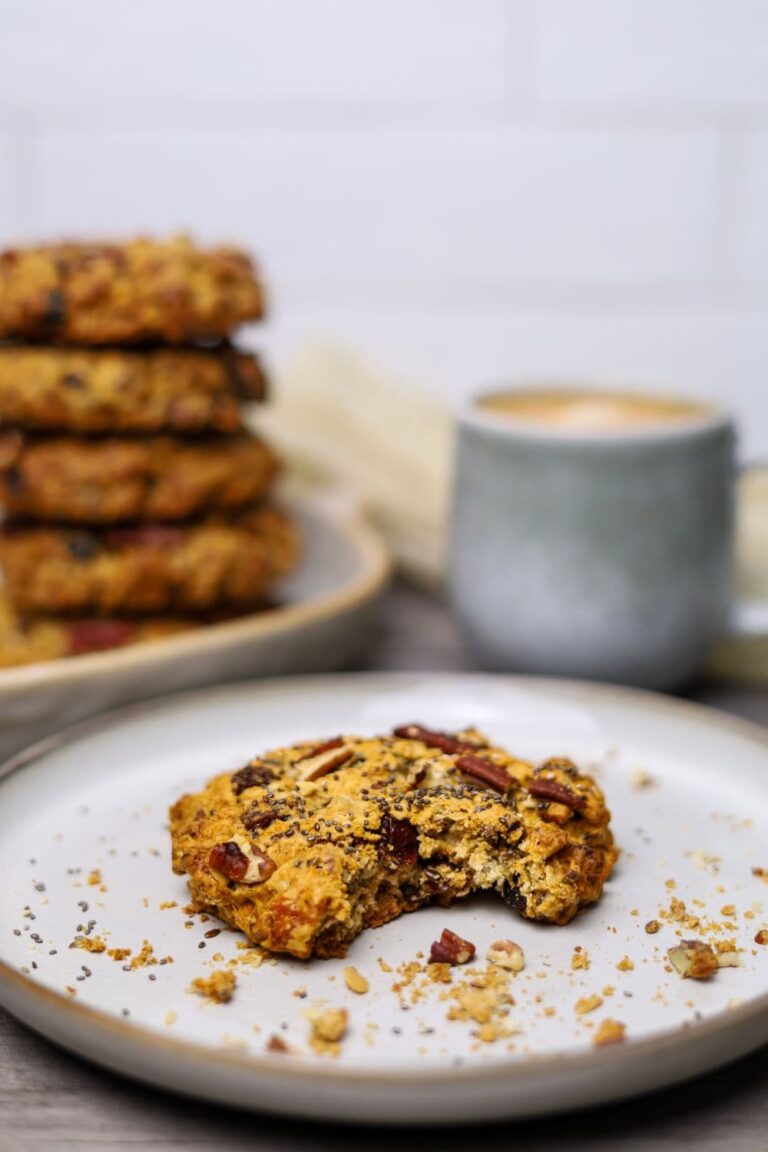

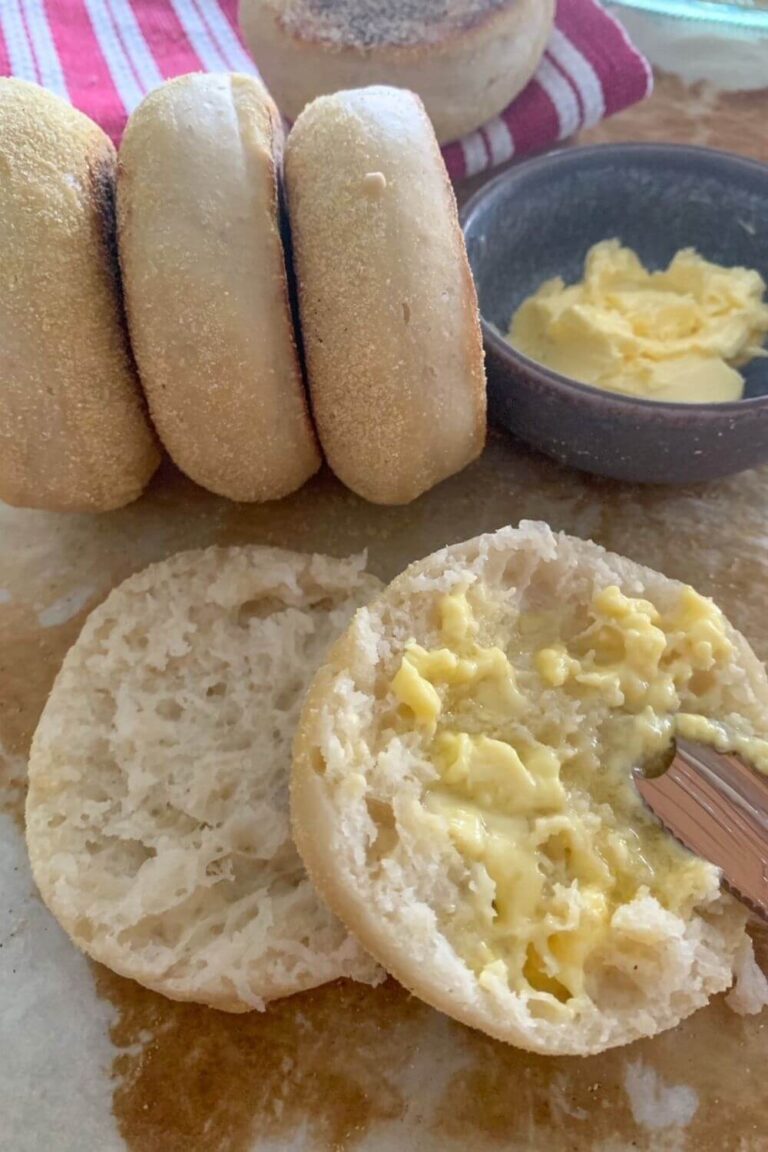
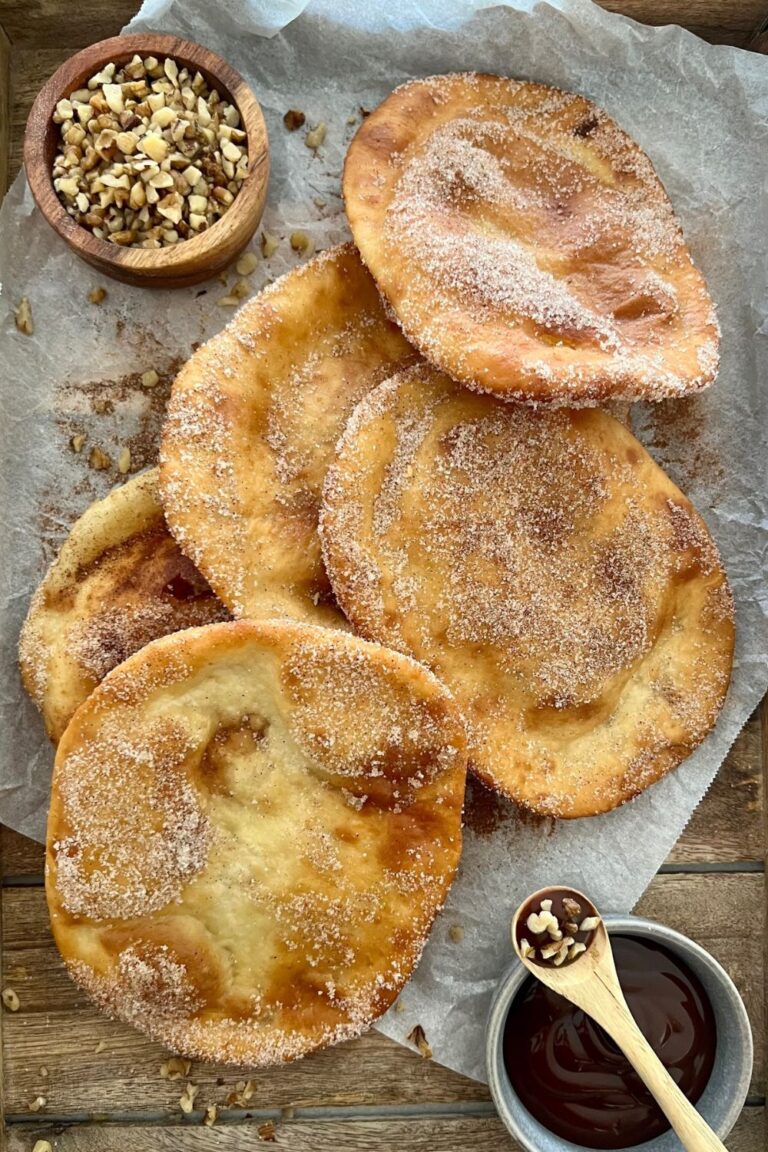

I made this! It tastes great and presented well! Thank you for the recipe!
Recipe looks great!
Nutrition info says for 100g serving, but it looks like it is actually the whole loaf (63 g protein for instance does not make sense!)
How much rosemary do you add?
Hi! I am loving your site. I have finally been able to perfect my sourdough loaf taste. I am going to make a cheddar loaf today. Am I able to add roasted garlic to it during shaping even though I add the cheddar during the stretch and folds? Thanks for all that you do.
Absolutely you can do it that way for sure 🙂 Sounds so good! xo
When do you put in the oil? I don’t see that in the instructions.
Hello,
I am learning so much from your page. Thank you 🙂
My loaf always comes out well however the base of my bread in Dutch oven came out burnt last time.
I Want to try a smaller one this time. Can I reduce the quantity mentioned to half to make a small bread
Yes you can definitely halve the recipe, no problems, same baking time though 🙂
Hello!
If I'm wanting to add cheese to this recipe, how much would you recommend? Is there a rule of thumb measurement when adding inclusions?
I would try adding 100g of cheese during your second set of stretch and folds. And we would love to hear how it works for you. 🙂